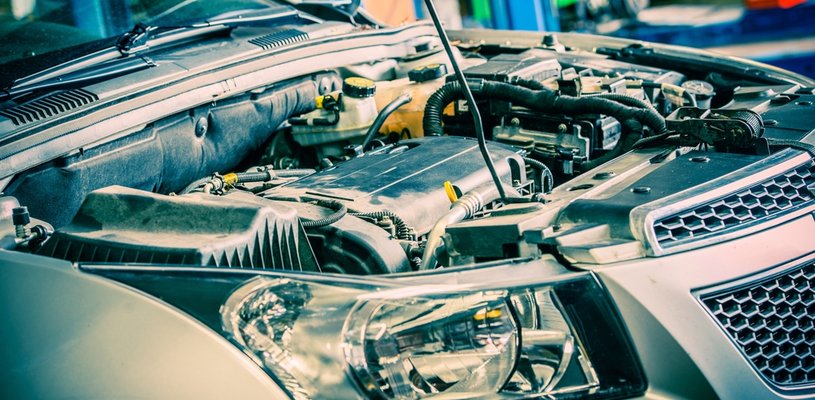
Performing basic car maintenance on your car will reduce your chances of breaking down, increase the likelihood of passing your MOT and prolong the life of your car. Follow our essential car maintenance guide and you’ll be making sure that your car is always in optimum condition.
Related: What You Should Always Keep in Your Car
Unlike an MOT, getting your new car serviced isn’t a legality but we recommend getting your car serviced every twelve months or 12000 miles, or 6 months and 6,000 miles if you drive your car a lot. A basic car service can certainly enhance the chances of your car passing its MOT. A car service is a complicated and long job that requires heavy lifting equipment as the wheels need to be removed and the suspension and brakes need to be checked.
The majority of modern cars feature an built-in computer that triggers a warning light - usually in the image of a spanner - that flashes up on the dashboard when your car needs a service.
The Tyres
You should always check your car’s tyre pressure before any long journey. When it comes to checking your tyres you need to look for any cuts or bulges in the sidewall. Should you find any bulges or cuts in the tyres, we recommend getting in touch with your local garage and asking for their advice. Do not drive the car until the problem with your tyres has been rectified and you’ve been given the all clear.
Check the tyre pressure
Using a tyre pressure gauge, check the pressure of each tyre. Your car’s handbook will specify what the pressure of your car’s tyres should be. In an emergency 30 PSI (pounds per square inch) will suffice, until you get them inflated to the recommended pressure.
Check the tyre tread
Before any long journey and every so often you should check your tyre tread. 1.6mm is the legal minimum in a continuous band across three-quarters of the width of the tyre. If your tyre doesn’t meet the legal requirement, you will face a fine of up to £2,500 and three penalty points on your driving licence – per tyre.
You can check the tyre tread using a 20 pence piece. Simply place the 20p in the groove of the tyre, and if the tread covers the outer rim of the 20 pence then you’re good to go! It is important to remember that for adverse weather conditions, 3MM is the recommended tyre tread.
Check your engine oil
The basics of checking your engine oil is very simple, and in most modern cars there will be a check oil light that signals when it is time to check your car’s oil level. In most cars, your dipstick and oil filler cap are yellow, so you shouldn’t have a problem finding them. If you can’t find the oil in your car, then check your car’s handbook.
How to check your car’s oil levels
-
If you’ve been using the car, switch off the engine and leave it to cool for five minutes or more - this lets the oil drain into the bottom of the engine. Remember that when the engine has been running, everything under the bonnet (including the oil) will be very hot.
-
Locate the oil under the bonnet.
-
Remove the dipstick. Wipe it down a lint-free cloth or with some kitchen roll.
-
Put the dipstick back in and make sure it is fully in there. Remove the dipstick once again - this will show you where the oil level is.
-
There should be two marks on your dipstick and the gap between the two is one litre. These are there to help you determine whether you need to add a whole one-litre bottle, or just a small part of it.
-
If you need to replenish the oil then remove the oil filler cap and top it up carefully - try not to spill any on the engine.
-
Allow enough time for the oil to drain to the bottom of the engine. Re-wipe the dipstick and re-check the oil level.
-
Continue this until your car’s oil is level meets the ‘full’ mark on your dipstick.
-
Replace the dipstick and oil filler cap.
You should check the oil before any long journey and every so often.
The drive belts
Drive belts are the rubber belts (a bit like the old fan belt) under the bonnet of your car. To check them, all you have to do is have a quick look at them to make sure they aren’t frayed and torn. You should also press down on the drive belts - they shouldn’t deflect by more than an inch or so. If you find any issues, then book your car in with your local garage.
Check the car’s battery
In most modern cars, the batteries are sealed which means you don’t have to top them up. If this is the case with your car, you just need to check the battery terminals - these are two metal clamps that have a thick lead coming out of each of them.
To check them all you need to do is try and wiggle them - should they move, then just tighten them up with the correct spanner until they don’t move anymore. We recommended checking your car’s battery monthly.
To find out more about your cars battery and any reasons why your car many not start, click here.
Check the car’s lights
Unless you have a reflective surface, checking your car’s lights is often a two person job. All you have to do is sit in the car and have someone confirm whether your front lights, back lights and brake lights are working. If they’re not, then you can either change the car’s light bulbs yourself or get someone else to do it.
In some new models of cars, if the indicator warning light on the dashboard goes much faster then it may signify that one of the indicator bulbs has blown.
You should check your car’s lights before any long car journey and every few weeks.
Check your wipers and windscreen
Checking your windscreen and wipers is a very simple job that takes seconds. Just lift each wiper arm up carefully and check that the wiping edge of the rubber strip isn’t nicked, cut or torn. Windscreen wipers are easy to replace on your own, or you can pay a mechanic to do so for you.
Once you’ve checked your windscreen wipers, you should check your car’s windscreen washer fluid reservoir and make sure that it is full. All you need to do is top it up with windscreen washer fluid - you can purchase this pre-mixed or concentrated. Concentrated washer fluid is is cheaper but needs to be mixed with water before it is used. Don’t use plain water - it will freeze in winter, affecting your vision. This should be done before every long journey and every few weeks.
Related: Quick Was to De-Ice Your Car
Check the brakes and clutch fluid
Before any long journey you should always check your brakes and the clutch fluid. This is a fairly straight forward job that should be done regularly in order to prevent a serious accident. Your car’s handbook will state where you need to look and where the ‘full’ mark is.
If you find the fluid level has dropped by no more than 2-3mm, then just top it up with the correct right fluid (your handbook will tell you which fluid you need) at any petrol station or local garage. If it has dropped by more than 2-3mm, then you should get it checked because it’s picking up the slack as your car’s brake pads wear. If your clutch fluid levels have dropped by large amounts, it may be a signal that you have a leak and you shouldn’t drive the car until you have had it repaired.
Check your engine coolant
The car’s coolant system keeps the car’s engine cool under most circumstances and weather conditions. When you check the car’s coolant engine, you should look around for any leaks. You should also inspect the area for any thick black rubber hoses coming from the radiator and check that no fluid is seeping out of the ends.
Give the black rubber hoses a squeeze - they should feel firm and robust. If they feel weak and flaccid then it’s advised to get them checked at your local garage, as they might not be working.
To check the car’s coolant level, you should ensure that the engine is stone cold as hot coolant is under pressure and taking the cap off will release a torrent of boiling fluid, which can cause severe burns. After the engine has cooled, remove the cap on the coolant tank and check the fluid inside - it should be blue or pink colour and free of oil. If the coolant isn’t up to the mark, top it up with a pre-mixed antifreeze solution to the top. If you need to top your coolant up a lot then you should take your car to the garage as it may suggest there is a leak.


